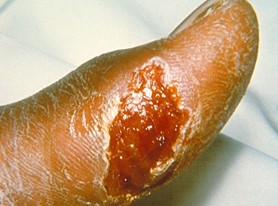Tularemia Testing and Treatment
Consult Infectious Diseases for assistance with testing and treatment
Laboratory Testing
-
Serologic testing (IgM and/or IgG): Paired acute and convalescent serum samples may be necessary to confirm diagnosis
-
A culture of the infected tissue (swab or scarping of ulcer) or specimen (lymph node aspirate, pharyngeal swab, or pleural fluid specimen) dependent upon the form of illness is the diagnostic standard. However, cultures require safety policies and procedures are followed to minimize the risk of laboratory transmission
-
Notify Microbiology to prevent lab staff exposure if tularemia is suspected and cultures are ordered or being sent from another hospital

Ulcer at Inoculation Site
Treatment
Preferred treatment: Gentamicin 5 - 7.5 mg/kg/dose IV once daily for 7 - 14 days
-
-
Obtain gentamicin levels after the first or second dose (contact Pharmacy for guidance)
-
Goal peak 8 - 12 mcg/mL, goal trough < 0.5 mcg/mL
-
Alternative treatment, if unable to obtain gentamicin: Streptomycin 7.5 mg/kg/dose IM three times daily for 7 - 14 days
References
Centers for Disease Control and Prevention. (1964). Tularemia ulcerative skin lesion [Digital Image]. https//phil.cdc.gov/
Centers for Disease Control and Prevention. (2022). Tickborne diseases of the United States: A reference manual for healthcare providers (6th ed.). U.S. Department of Health and Human Services. https://www.cdc.gov/ticks/hcp/data-research/tickborne-disease-reference-guide/
Pace, E. J., & O'Reilly, M. (2020). Tickborne diseases: Diagnosis and management. American Family Physician, 101(9), 530-540. https://www.aafp.org/afp/2020/0501/p530.html
These pathways do not establish a standard of care to be followed in every case. It is recognized that each case is different, and those individuals involved in providing health care are expected to use their judgment in determining what is in the best interests of the patient based on the circumstances existing at the time. It is impossible to anticipate all possible situations that may exist and to prepare a pathway for each. Accordingly, these pathways should guide care with the understanding that departures from them may be required at times.